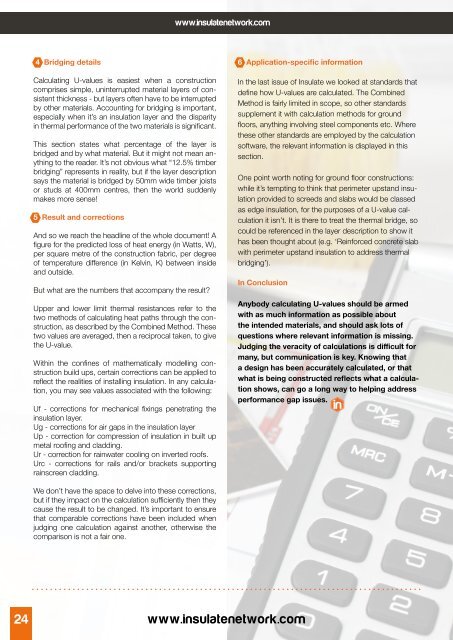Insulate Magazine Issue 12 - November 2017
The 1st Birthday issue of Insulate magazine titled "Round 12 with Recticel" features an exclusive interview with Recticel's commercial Director Kevin Bohea. If that wasn't enough we have a great exclusive inside the BBA, featuring an interview with BBA Chef Executive Richard Beale.
The 1st Birthday issue of Insulate magazine titled "Round 12 with Recticel" features an exclusive interview with Recticel's commercial Director Kevin Bohea. If that wasn't enough we have a great exclusive inside the BBA, featuring an interview with BBA Chef Executive Richard Beale.
You also want an ePaper? Increase the reach of your titles
YUMPU automatically turns print PDFs into web optimized ePapers that Google loves.
www.insulatenetwork.com<br />
4 Bridging details<br />
Calculating U-values is easiest when a construction<br />
comprises simple, uninterrupted material layers of consistent<br />
thickness - but layers often have to be interrupted<br />
by other materials. Accounting for bridging is important,<br />
especially when it’s an insulation layer and the disparity<br />
in thermal performance of the two materials is significant.<br />
This section states what percentage of the layer is<br />
bridged and by what material. But it might not mean anything<br />
to the reader. It’s not obvious what “<strong>12</strong>.5% timber<br />
bridging” represents in reality, but if the layer description<br />
says the material is bridged by 50mm wide timber joists<br />
or studs at 400mm centres, then the world suddenly<br />
makes more sense!<br />
5 Result and corrections<br />
And so we reach the headline of the whole document! A<br />
figure for the predicted loss of heat energy (in Watts, W),<br />
per square metre of the construction fabric, per degree<br />
of temperature difference (in Kelvin, K) between inside<br />
and outside.<br />
But what are the numbers that accompany the result?<br />
Upper and lower limit thermal resistances refer to the<br />
two methods of calculating heat paths through the construction,<br />
as described by the Combined Method. These<br />
two values are averaged, then a reciprocal taken, to give<br />
the U-value.<br />
Within the confines of mathematically modelling construction<br />
build ups, certain corrections can be applied to<br />
reflect the realities of installing insulation. In any calculation,<br />
you may see values associated with the following:<br />
Uf - corrections for mechanical fixings penetrating the<br />
insulation layer.<br />
Ug - corrections for air gaps in the insulation layer<br />
Up - correction for compression of insulation in built up<br />
metal roofing and cladding.<br />
Ur - correction for rainwater cooling on inverted roofs.<br />
Urc - corrections for rails and/or brackets supporting<br />
rainscreen cladding.<br />
6 Application-specific information<br />
In the last issue of <strong>Insulate</strong> we looked at standards that<br />
define how U-values are calculated. The Combined<br />
Method is fairly limited in scope, so other standards<br />
supplement it with calculation methods for ground<br />
floors, anything involving steel components etc. Where<br />
these other standards are employed by the calculation<br />
software, the relevant information is displayed in this<br />
section.<br />
One point worth noting for ground floor constructions:<br />
while it’s tempting to think that perimeter upstand insulation<br />
provided to screeds and slabs would be classed<br />
as edge insulation, for the purposes of a U-value calculation<br />
it isn’t. It is there to treat the thermal bridge, so<br />
could be referenced in the layer description to show it<br />
has been thought about (e.g. ‘Reinforced concrete slab<br />
with perimeter upstand insulation to address thermal<br />
bridging’).<br />
In Conclusion<br />
Anybody calculating U-values should be armed<br />
with as much information as possible about<br />
the intended materials, and should ask lots of<br />
questions where relevant information is missing.<br />
Judging the veracity of calculations is difficult for<br />
many, but communication is key. Knowing that<br />
a design has been accurately calculated, or that<br />
what is being constructed reflects what a calculation<br />
shows, can go a long way to helping address<br />
performance gap issues.<br />
We don’t have the space to delve into these corrections,<br />
but if they impact on the calculation sufficiently then they<br />
cause the result to be changed. It’s important to ensure<br />
that comparable corrections have been included when<br />
judging one calculation against another, otherwise the<br />
comparison is not a fair one.<br />
24<br />
www.insulatenetwork.com













